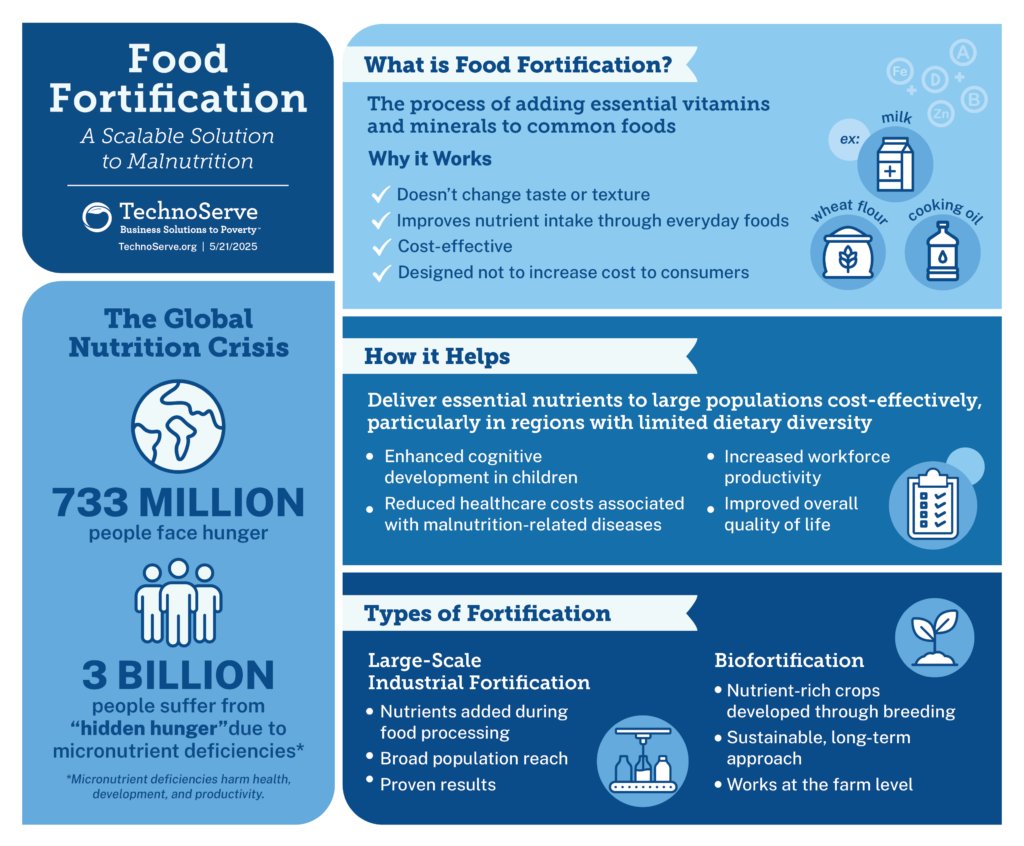
Food Fortification: The Key to Tackling Malnutrition at Scale
In a world where nearly 733 million people face hunger and three billion people suffer from micronutrient deficiencies, food fortification is a critical tool to improve global nutrition. TechnoServe recognizes food fortification as essential for addressing malnutrition at scale.
Understanding Food Fortification
Food fortification involves enriching staple foods with essential micronutrients, such as vitamins and minerals. By increasing the nutrient density of staple foods, fortification has become a critical global approach to enhancing population-wide nutrition and health.

Definition and Purpose
Food fortification is the process of deliberately increasing the content of essential micronutrients, such as vitamins, minerals, and other critical nutrients, in staple foods. This strategic approach addresses nutritional gaps and improves public health by enhancing the nutritional value of commonly consumed foods without significantly altering their taste, texture, or cost.
Historical Background
The practice of food fortification in its modern form has roots dating back to the early 20th century, with pioneering efforts focused on addressing specific nutritional deficiencies. Salt iodization to prevent goiter and flour enrichment to combat vitamin B deficiencies were among the earliest widespread fortification programs. Over the decades, these interventions have evolved, becoming a globally recognized strategy for improving population-wide nutrition.

Why is Food Fortification Important?
Food fortification plays a critical role in addressing micronutrient deficiencies and driving long-term economic development. By enhancing the nutrient content of everyday staples, fortification supports healthier populations, reduces the incidence of preventable diseases, and contributes to sustainable livelihoods.
Addressing Micronutrient Deficiencies
Micronutrient deficiencies, often referred to as “hidden hunger,” can have a profound impact on individual and community health. By fortifying staple foods like wheat flour, rice, milk, and cooking oils, we can cost-effectively deliver essential nutrients to millions of people, particularly in regions with limited dietary diversity.
Public Health and Economic Benefits
Improved nutrition through fortification translates directly into economic and social benefits. Better-nourished populations experience:
- Enhanced cognitive development in children
- Increased workforce productivity
- Reduced healthcare costs associated with malnutrition-related diseases
- Improved overall quality of life
Types of Food Fortification and Their Benefits
Two critical types of food fortification are large-scale (industrial) fortification and biofortification. Industrial fortification integrates micronutrients during the manufacturing process, and biofortification involves developing new crop varieties with higher levels of nutrients.
Large-Scale (Industrial) Fortification
Industrial fortification represents the most efficient method of delivering nutrients on a large scale. By integrating micronutrients during the manufacturing process, we can ensure consistent nutrient delivery across vast populations. TechnoServe’s Inspiring Good Nutrition Initiatives Through Enterprise (IGNITE) program, operating across eight countries, exemplifies this approach by working with millers to enhance their staple food fortification capabilities and compliance with national food fortification standards.
Biofortification: Enhancing Crops Naturally
Biofortification provides an innovative approach to enhancing nutrition by breeding crops with improved nutritional profiles. This method involves developing crop varieties that naturally contain higher levels of essential nutrients, providing a sustainable solution to micronutrient deficiencies.

Advantages and Challenges of Food Fortification
Food fortification has significant potential to improve nutrition and economic development. Yet, the approach faces substantial implementation challenges, including ensuring high-quality inputs and addressing high testing costs and inconsistent regulatory oversight.
Benefits for Public Health and Economic Development
Food fortification represents a cost-effective intervention with far-reaching impacts. By investing in the nutritional enhancement of staple foods, we can:
- Reduce the economic burden of malnutrition
- Improve overall population health
- Support long-term community development
Implementation Challenges and Cost Considerations
Large-scale food fortification faces several challenges that need to be addressed for effective implementation.
- While large-scale food fortification is designed to minimize additional costs to consumers, the cost of the large volume of inputs to millers, and the increased cost of seeds to farmers in the case of biofortification, requires good business planning, especially where access to foreign exchange for imports is constrained
- Increasing raw material costs can lead companies to give up fortification or use cheaper ingredients with poorer nutritional value
- Testing the nutritional quality of products requires special skills and equipment, which can be expensive
- There can be weak or haphazard regulatory oversight, which penalizes companies trying to fortify properly and lacks enforcement for those not fortifying to standards or at all
Fortification Policies and Global Standards
The landscape of food fortification is shaped by two primary approaches: mandatory and voluntary fortification.
- Mandatory fortification involves government regulations that require food producers to add specific nutrients to designated staple foods.
- Voluntary fortification allows food manufacturers to choose whether or not to fortify their products, typically driven by market demands or perceived health benefits.
Organizations like the World Health Organization and the Food and Agriculture Organization have developed comprehensive guidelines to standardize fortification practices. These frameworks ensure:
- Nutrient quality and safety
- Appropriate fortification levels
- Monitoring and evaluation mechanisms
TechnoServe’s Success in Food Fortification
TechnoServe is involved in food fortification initiatives aimed at combating malnutrition by enhancing the nutritional value of staple foods, often through partnerships with food processors and governments. We work to promote fortification, establish sustainable practices, and ultimately improve the health and well-being of vulnerable communities.
- Strengthening African Processors of Fortified Foods (SAPFF) was implemented by TechnoServe in Kenya, Tanzania, and Nigeria from 2016 to 2022 to learn how to engage, motivate, and improve the food fortification performance of the milling industry. The program focused on capacity building, responsive technical assistance, and multistakeholder engagement.
The SAPFF team contacted a large processor in Nigeria to discuss improving the fortification rates of their edible oil through hands-on staff training. Equipped with post-training fortification knowledge, the miller identified a lack of vitamin A testing devices as a barrier to fortification compliance. The cost of the devices was shared between the miller and SAPFF through a matching grants fund. The support enabled the miller to meet compliance and deepened the relationship with SAPFF. As a result of the positive interaction and trust-building, the mill’s managing director served as a champion for SAPFF, playing an integral role in the Nigeria Leadership Forum and leading the effort to establish an industry peer review mechanism on behalf of the CEOs. - Inspiring Good Nutrition Initiatives Through Enterprise (IGNITE) was launched in 2023 to build on and expand the success of the SAPFF program to new countries. To strengthen the connection between millers and suppliers of high-quality equipment and inputs, IGNITE launched Millers for Nutrition, a coalition of key food fortification stakeholders dedicated to helping millers fortify staple foods in eight African and Asian countries, including Bangladesh, Ethiopia, India, Indonesia, Kenya, Nigeria, Pakistan, and Tanzania.
IGNITE also launched the Micronutrient Fortification Index, which measures and ranks leading staple food brands based on the quality of their fortified products, leading to significant improvements in product quality compliance and recognition of food fortification excellence.
In 2023, Millers for Nutrition met with a large oil producer in Kenya to discuss fortification rates. Recommendations to the general manager and quality control staff included changing fortification ingredient suppliers. Subsequent tests demonstrated that by enhancing the quality of the ingredients, the company could meet the fortification requirements. To maintain compliance, Millers for Nutrition encouraged in-house testing and trained quality control staff on a procedure to spot-test products. Since then, the miller has requested additional support, including a safety management system and lean management training.
Lessons Learned and Best Practices
Key insights from our work include:
- Large-scale food fortification relies on collaboration across public and private sectors. Public entities establish fortification requirements and oversee regulatory compliance, ensuring that fortified foods meet established standards. Strategic fortification partners support millers through knowledge sharing and hands-on training. By working together, these sectors can overcome challenges, optimize fortification efforts, and ultimately improve nutritional outcomes on a large scale.
- One size does not fit all. Millers face a variety of challenges across businesses, markets, and food vehicles that require context-specific solutions. In addition to food fortification support, millers may require further assistance with branding and marketing, sourcing ingredients, identifying new markets, and other business advisory services.
- Trust and relationship building are key. Fostering strong relationships is paramount to enhancing food fortification rates. Cultivating trust through consistent, positive interactions, such as delivering tailored technical assistance and demonstrating tangible business efficiencies, not only fosters increased fortification but can also empower millers to become long-term advocates for nutritional improvement.
Building a Healthier Future Through Food Fortification
By enhancing the nutritional profile of everyday foods that reach billions of people, we create an opportunity to address malnutrition on an unprecedented scale. As we’ve seen through TechnoServe’s work across multiple countries, successful fortification programs require a delicate balance of technical expertise, policy support, industry engagement, and consumer awareness. The global challenge of malnutrition may seem daunting, but food fortification offers a proven, cost-effective solution that can reach populations where they are, through the foods they already consume.






